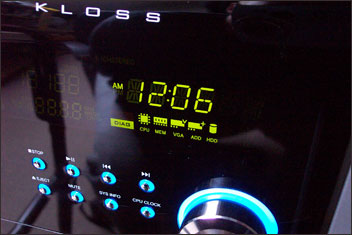External Appearance II
The KLOSS KL-I915A's front panel section is the coolest part of its appearance, complementing the brushed aluminium appearance and general aesthetic very well in my opinion. With power applied to the KLOSS, there's a clock display that shows through the front panel showing you the current time.Notice the buttons and volume/selector dial unlit. Push the power button to start the boot process and the now-standard blue LED lighting kicks in.
That photograph gives you an idea of some of the information that the display panel will show you during operation of the KLOSS.
There's a small microcontroller on the mainboard that can interface with the mainboard and BIOS that relays certain information to the front panel. CPU speed is one of those bits of information and you can see the KLOSS running the 3.6GHz Prescott I used for testing.
It's during bootup is where the front panel really comes to life, giving you a twist on the POST information display that you'll see on other mainboards.
A successful boot for the KLOSS looks like that, the display flashing the DIAG label and showing you a full set of lights for each of the major components that it checks during POST. If there's a problem with anything on boot, the KLOSS will show you something like this.
In that case, the KLOSS couldn't initialise an add-in PCI Express graphics card and so shows its label lit up with the FAIL display to accompany it. I don't know about you, but to look at that display and see instantly what's wrong with a system, rather than decode a POST code display or a set of BIOS beeps, is one of the small touches that make you really enjoy a computer system.
Referring back to this picture lets you see the smaller buttons on the front panel that let you control some of the KLOSS's features. On the left you have power and reset and a set of audio controls (more on those later), along with two buttons labelled CPU CLOCK and SYS INFO.
CPU CLOCK switches between three CPU speed and fan states that you can setup in the BIOS, labelled Normal, Silent and Turbo. Silent lowers the clock speed of the processor based on a percentage amount that you choose in the BIOS as well as reducing the fan speed, Turbo activates an overclocked setting that you also define in the mainboard's BIOS. More on those settings during BIOS discussion. The button simply cycles through the three choices and the change happens instantly.
SYS INFO lets you toggle what's shown by the front panel in terms of system properties. You can choose to show current CPU frequency, the size of the primary hard drive, how much memory is installed and the current monitored CPU temperature. The boot-up default is to cycle through everything with an interval of a second or two. Pressing the button selects one of the individual settings and keeps it displayed permanently. To revert back to the cycling mode, just hold down SYS INFO for a few seconds and release it.
There's also a display of activity on the IDE and LAN interfaces, the label lighting up when data is being moved across them.
The KLOSS can't act like an MSI MEGA PC and have the audio controls work outside of booting an operating system. The controls only work in Windows (a quick boot of Knoppix didn't have much happening in that Linux distribution) but they do work well.
The display is easily the most attractive external feature that the KLOSS has, but there's similar exciting things to look at inside.














